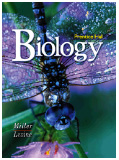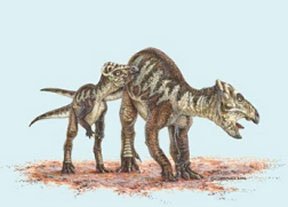BIOLOGY
by Miller & Levine
[complete Table of Contents]

|
Use the pull-down menu to jump to any of the Book's 40 Chapters: |
Additional Resources:
![]() Chapter 17
Chapter 17 ![]()
The History of Life
In this chapter, students will read about the major periods and events in the history of life on Earth. Students will also read about the use of fossil stratigraphy and radioactive dating to establish the chronology of the fossil record and major patterns of macroevolutionThe links below lead to additional resources to help you with this chapter. These include Hot Links to Web sites related to the topics in this chapter, the Take It to the Net activities referred to in your textbook, a Self-Test you can use to test your knowledge of this chapter, and Teaching Links that instructors may find useful for their students.
| Hot Links | |
| Take it to the Net | Teaching Links |
What are Web Codes? |
Web
Codes for Chapter 17:: |
![]()
Section
17-1: The Fossil Record
![]() The
fossil record provides evidence about the history of life on Earth. It
also shows how different groups of organisms have changed over time.
The
fossil record provides evidence about the history of life on Earth. It
also shows how different groups of organisms have changed over time.
 Relative dating allows paleontologists
to estimate a fossil's age compared with that of other fossils.
Relative dating allows paleontologists
to estimate a fossil's age compared with that of other fossils.
 In radioactive dating, scientists calculate
the age of a sample based on the amount of remaining radioactive isotopes
it contains.
In radioactive dating, scientists calculate
the age of a sample based on the amount of remaining radioactive isotopes
it contains.
 After Precambrian Time, the basic divisions
of the geologic time scale are eras and periods.
After Precambrian Time, the basic divisions
of the geologic time scale are eras and periods.
Section
17-2: Earth's Early History
 Earth's early atmosphere
probably contained hydrogen cyanide, carbon dioxide, carbon monoxide,
nitrogen, hydrogen sulfide, and water.
Earth's early atmosphere
probably contained hydrogen cyanide, carbon dioxide, carbon monoxide,
nitrogen, hydrogen sulfide, and water.
 Miller and Urey's experiments suggested
how mixtures of the organic compounds necessary for life could have arisen
from simpler compounds present on a primitive Earth.
Miller and Urey's experiments suggested
how mixtures of the organic compounds necessary for life could have arisen
from simpler compounds present on a primitive Earth.
 The rise of oxygen in the atmosphere
drove some life forms to extinction, while other life forms evolved new,
more efficient metabolic pathways that used oxygen for respiration.
The rise of oxygen in the atmosphere
drove some life forms to extinction, while other life forms evolved new,
more efficient metabolic pathways that used oxygen for respiration.
 The endosymbiotic theory proposes that
eukaryotic cells arose from living communities formed by prokaryotic organisms.
The endosymbiotic theory proposes that
eukaryotic cells arose from living communities formed by prokaryotic organisms.
Section
17-3: Evolution of Multicellular Life
 Early in the Paleozoic
Era, the fossil record became rich with evidence of many types of marine
life.
Early in the Paleozoic
Era, the fossil record became rich with evidence of many types of marine
life.
 During the Devonian, animals began to
invade the land.
During the Devonian, animals began to
invade the land.
 The mass extinction at the end of the
Paleozoic affected both plants and animals on land and in the seas. As
much as 95 percent of the complex life in the oceans disappeared.
The mass extinction at the end of the
Paleozoic affected both plants and animals on land and in the seas. As
much as 95 percent of the complex life in the oceans disappeared.
 Events during the Mesozoic include the
increasing dominance of dinosaurs. The Mesozoic is marked by the appearance
of flowering plants.
Events during the Mesozoic include the
increasing dominance of dinosaurs. The Mesozoic is marked by the appearance
of flowering plants.
![]() During the Cenozoic,
mammals evolved adaptations that allowed them to live in various environments—on
land, in water, and even in the air.
During the Cenozoic,
mammals evolved adaptations that allowed them to live in various environments—on
land, in water, and even in the air.
Section
17-4: Patterns of Evolution
 Six important patterns
of macroevolution are mass extinctions, adaptive radiation, convergent
evolution, coevolution, punctuated equilibrium, and changes in developmental
genes.
Six important patterns
of macroevolution are mass extinctions, adaptive radiation, convergent
evolution, coevolution, punctuated equilibrium, and changes in developmental
genes.

